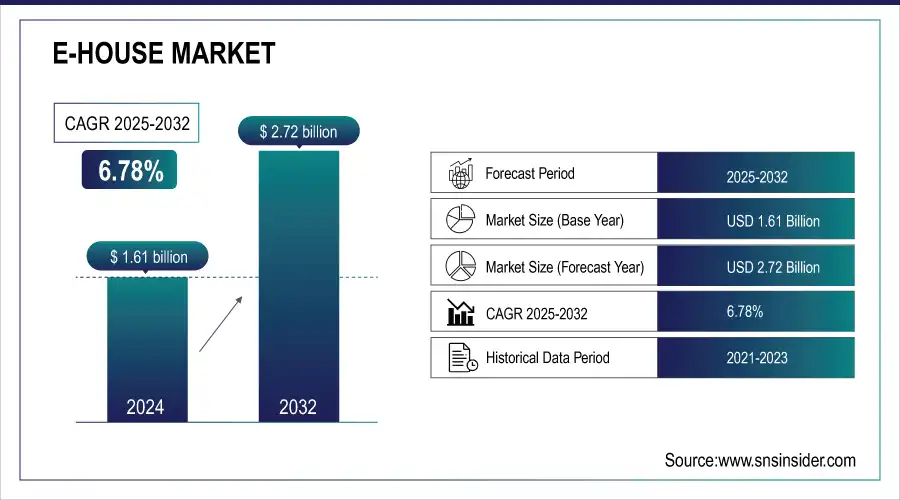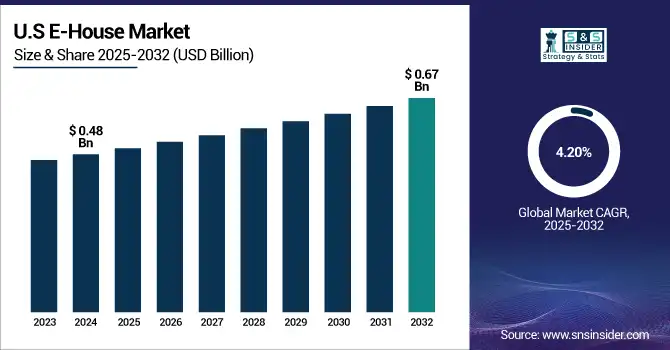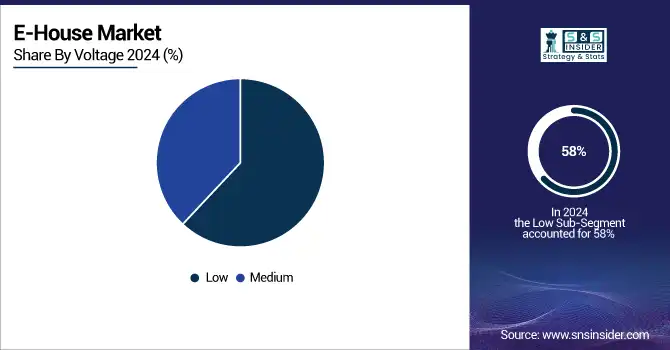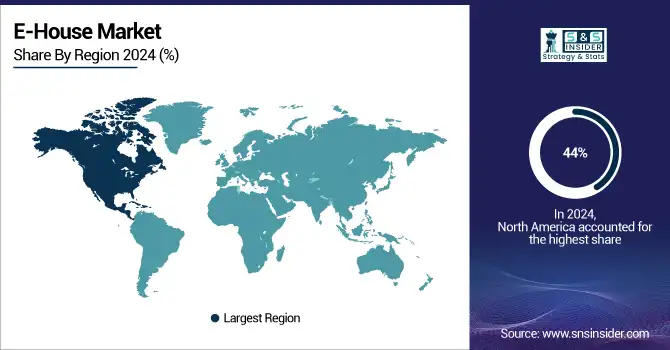E-House Market Size & Growth:
The E-House Market size was valued at USD 1.61 Billion in 2024 and is projected to reach USD 2.72 Billion by 2032, growing at a CAGR of 6.78% during 2025-2032. The E-House market is witnessing robust growth, driven by the increasing demand for modular, prefabricated power distribution solutions in offshore and remote industrial applications. This innovative tiny electric home makes it also easy to integrate power systems in compact and difficult environments. The factors contributing to the increasing adoption of digital oilfield services market are high complexity in subsea and onshore energy infrastructure, rapid deployment and the escalating emphasis on digitalization and automation. To achieve such milestones during E-House development, manufacturers rely on multifaceted knowledge to engineer, build and test innovative E-House solutions that are scalable, remotely diagnosable, and reliable across challenging operational environments. High demand in key emerging offshore markets helps, but other supports include strong order backlogs (some three years out at leading firms), ongoing innovation in structural and system-level integration, and a closer fit with evolving offshore energy requirements and smart grid imperatives.

To Get more information on E-House Market - Request Free Sample Report
May 28, 2025 – Scana PSW Power & Automation has been awarded a contract of NOK 75-150 million for the delivery of two E-House modules related to subsea power distribution in an offshore installation.
The U.S E-House Market size was valued at USD 0.48 Billion in 2024 and is projected to reach USD 0.67 Billion by 2032, growing at a CAGR of 4.20% during 2025-2032. The growth of the U.S. E-House market is due to increased demand for modular power infrastructure in utilities, oil & gas, and data centers. Growing investment in renewables, grid modernisation, and the demand for mobile electrification option, drives demand. In addition, further developed prefabrication, cybersecurity and remote monitoring will increase the reliability and deployment speed Hairpin E-Houses an attractive solution for mission-critical power distribution and in particularly those with applications in hard to reach places.

The E-House market Trends include the growing preference for modular and prefabricated power solutions to enable rapid deployment in remote or temporary locations. This enables real-time operational visibility, condition-based monitoring, and predictive maintenance through digital integration to IOT & SCADA systems. Increasing need of E-Houses in grid studies, renewable energy projects and offshore platform due to space and time limitations. 2. The use of lightweight, high-strength materials and small-form-factor, SWaP-optimized designs is growing Moreover, growing emphasis on the grid resilience, cyber security and smart gird compatibility impacting innovation in E-House architectures & configurations.
E-House Market Drivers:
-
Rising Power Demand from AI and EVs Drives Modular E-House Adoption for Scalable Energy Distribution
The rapid growth of artificial intelligence (AI) data centers and electric vehicle (EV) uptake, meanwhile, is only increasing electricity demand — driving significant requirements for flexible but large-scale power infrastructure. E-Houses provide modular, compact and quickly deployable energy distribution solutions that enable the end-around traditional substation building wait times. These features have made them the anchor to renewable integration, a firm backup source of power and meeting the high energy requirements of digital as well as industrial applications thus making them an indispensable asset in the modern energy ecosystems. With E-Houses playing a central and enabling role in the delivery of localized power where it is needed most, their ability to support carbon neutral energy infrastructures surfaces as a burning question for all industries rapidly transitioning to electrified, data driven operations.
May 22, 2025 – May 22, 2025 – A U.S. House Tax Bill Could Doom Key Solar Tax Credits, Add 7% To Electricity Bills By 2026 And Slow AI And EV Energy Growth While Boosting China Energy & Tech Overnight-Based on E&E News LetterEnergy release date Nov.
E-House Market Restraints:
-
High Customization Costs and Harsh Operating Environments Hinder E-House Market Expansion
The E-House market faces significant restraints due to high customization and installation costs associated with integrating modular substations into diverse infrastructure environments. In the case of EV chargers, every project tends to feature custom design work and engineering as well as compliance with local electrical and safety standards also leading to significant upfront costs sight unseen. Furthermore, ruggedized encasement and climate control implementation are needed in order to protect against local oppressive working environments (offshore, mines, desert) which means more cost that drives capital- and maintenance expense. It is an interoperability issue due to minimal standardization among applications, and this lack of a standardized format or process hinders the scaling ability. Additionally, scarcity of skilled professionals for the management of high-voltage modular systems is one of the major restraints hindering the development in emerging economies. These challenges in turn cumulatively impede widespread deployment of E-Houses into mobile or remote power solution demanding industries.
E-House Market Opportunities:
-
Growing Preference for Eco-Efficient High-Voltage Solutions Driving E-House Market Expansion
The increasing global focus on sustainable power systems is creating strong opportunities for E-House market growth, especially through the integration of SF₆-free gas-insulated switchgear (GIS). As regulatory bodies tighten emissions standards and environmental compliance becomes a priority, industries and utilities are actively seeking modular solutions that align with low-carbon goals. E-Houses with eco-efficient, high-voltage components adress these requirements by delivering a more compact and emission-free and parts. This trend is spurring advancements in switchgear technology and accelerating the uptake of green E-House units on transmission and distribution networks, especially large infrastructure projects with overarching designs focused on decarbonization and modernizing the grid.
July 5, 2025 – Hitachi Energy will deliver the world’s first SF₆-free 550 kV gas-insulated switchgear (GIS) to SGCC’s Central China Branch.The eco-efficient EconiQ technology aims to cut emissions and support China’s 2060 carbon neutrality goals.
E-House Market Challenges:
-
Rising Material Costs and Supply Chain Disruptions Impact E-House Deployment Efficiency
The E-House market is facing significant challenges due to rising material costs and global supply chain disruptions. The increased demand for copper, steel, insulation materials, and high-voltage components coupled with inflationary pressures has led to higher production and procurement costs. This cost surge affects the affordability and scalability of E-House solutions, particularly in developing regions. Additionally, delays in component availability disrupt project timelines and strain vendor-client relationships. This effort is further complicated by geopolitical tensions and logistical bottlenecks, hampering the ability of manufacturers to respond quickly. This in turn is leading to project delays and cost overruns, which may hamper the uptake of E-Houses across rapidly expanding energy and industrial industries.
Segmentation Analysis:
By Voltage
In 2024, the Low segment accounted for approximately 58% of the E-House market share, as it is widely used across utilities and non-electric sectors including mining and infrastructure projects where compact & cost-effective power distribution solutions are required. This segment is characterized by easy integrability, low installation costs, and has the ability to be used in multiple low-capacity application areas, which are key factors driving its market acceptance across industries having modular electrical requirements.
The Medium segment is expected to experience the fastest growth in E-House market over 2025-2032 with a CAGR of 9.37%, attributed to macroeconomic drivers such as increased infrastructural work, coupled with favorable unit economics that result in cost-effective power system upgrade paths. They are very suitable for high-load applications in utilities and heavy industries where a higher power capacity has to be challenged against oppotimizing costs.

By Sourcing Type
In 2024, the Mobile segment accounted for approximately 41% of the E-House market share, driven by its flexibility, faster deployment, and cost-efficiency. These mobile units are increasingly preferred for temporary power needs in remote and rapidly developing areas, especially in industries such as oil & gas, mining, and utilities, where quick, scalable power solutions are critical to operational continuity.
The Semi-Mobile segment is expected to experience the fastest growth in E-House market over 2025-2032 with a CAGR of 8.72%. And its capability of being an troop transport adds to that growth by providing that second balance of just the right amount of mobility without sacrificing structural stability which is perfect for deployments in the mid-term. Industries like infrastructure development and energy projects that require an easily transportable, semi-mobile E-House continue to incorporate this new medium in demand responsive power solutions.
By Component
In 2024, the Switchgear segment accounted for approximately 24% of the E-House market share, as these play an indispensable role for proper power distribution, control and protection in both industrial and utility installations. This growth is mainly due to the increased adoption in high-voltage networks since the modular and integrated switchgear systems ensure safety as well as improved operational efficiency. Rapid investments towards electrification and grid reliability will drive the expansion of the industry landscape.
The Control Panel segment is expected to experience the fastest growth in E-House market over 2025-2032 with a CAGR of 8.32%. with increased demand for the remote power and industrial sectors for advanced automation, remote monitoring and real-time control. With operations moving towards digitalization, the trend of smart control systems in compact and modular E-Houses gains traction especially for high end performance and mission critical activities.
By Application
In 2024, the Power Utilities segment accounted for approximately 35% of the E-House market share, making it the leading application area. This dominance is attributed to the growing need for reliable and modular power distribution units across substations and grid infrastructure. Utilities are increasingly adopting E-Houses for their ease of deployment, cost-efficiency, and integration of advanced equipment, helping to support grid modernization and electrification initiatives, especially in remote and rapidly urbanizing regions.
The Mining segment is expected to experience the fastest growth in E-House market over 2025-2032 with a CAGR of 8.32%.This surge is driven by increasing demand for medium-voltage applications in infrastructure and industrial projects that require compact, reliable, and modular power solutions. The segment benefits from enhanced deployment in utilities and manufacturing facilities aiming for efficient grid support and electrical distribution.
E-House Market Regional Outlook:
In 2024 North America dominated the E-House market and accounted for 44% of revenue share, This dominance was driven by robust investments in grid modernization, oil & gas infrastructure upgrades, and industrial electrification projects across the U.S. and Canada. The region also benefited from the presence of major E-House providers and early adoption of modular power solutions for remote and mobile applications, especially in the energy and mining sectors.

Get Customized Report as per Your Business Requirement - Enquiry Now
Asia-Pacific is expected to witness the fastest growth in the E-House market over 2025-2032, with a projected CAGR of 8.45% increasing industrialization and investments in renewable energy as well as rising interest for robust and modular electrical infrastructure in this region have driven the demand in developing economies. In this regard, countries in the region are upgrading their grid systems and establishing smart substations, which favors E-House deployment across power utilities, mining, and transportation among others.
In 2024, Europe emerged as a promising region in the E-House market, during which increasing investment on renewable energy infrastructure, stringent emission regulations and modernization of aging electrical grids are behind the growth. Decarbonization and increased energy efficiency in the utilities & industrial sector favouring sales of modular, eco-efficient E-House solutions in countries such as Germany, France and UK.
Latin America (LATAM) and the Middle East & Africa (MEA) regions are witnessing steady growth in the E-House market, due to new infrastructure development, energy access programs and increase in investment in oil, gas & mining sector. Capacity for faster implementation of power-to-exploit As the demand for Watts grow in off-grids, while there are project shortening and residential E (modular and scalable) are more time to come.
Key E-House Companies are:
The Major Players in E-House market are ABB Ltd., Siemens AG, Eaton Corporation, Schneider Electric, Powell Industries, General Electric (GE), WEG, Meidensha Corporation, TGOOD Global Ltd., Unit Electrical Engineering, Rockwell Automation, Delta Star Inc., Elgin Power Solutions, Matelec Group, Energia (Efacec Power Solutions), My Electric (MyE) Engineering, Efacec Power Solutions, Aktif Group, PCS International, Vertiv (formerly Emerson Network Power) and Others.
Recent Developments:
-
In June 2025, ABB to deliver advanced eHouse systems and automation solutions for P-84 and P-85 FPSO vessels, enhancing offshore energy efficiency and electrical safety in Brazil’s Atapu and Sépia fields.
-
In Dec 2024, Siemens to Supply Modular Power Skids for Compass DatacentersUnder a multi-year agreement, Siemens will deliver up to 1,500 prefabricated medium-voltage skid units to accelerate data center construction and support AI-driven demand growth.
| Report Attributes | Details |
|---|---|
| Market Size in 2024 | USD 1.61 Billion |
| Market Size by 2032 | USD 2.72 Billion |
| CAGR | CAGR of 6.78% From 2024 to 2032 |
| Base Year | 2024 |
| Forecast Period | 2025-2032 |
| Historical Data | 2021-2023 |
| Report Scope & Coverage | Market Size, Segments Analysis, Competitive Landscape, Regional Analysis, DROC & SWOT Analysis, Forecast Outlook |
| Key Segments | • By Sourcing Type(Mobile, Semi-Mobile and Fixed) • By Component(Switchgear, Transformer, UPS, Control Panel, Busway, HVAC System and Others) • By Voltage (Low and Medium) • By Application(Oil & Gas, Mining, Power Utilities, Transportation and Others) |
| Regional Analysis/Coverage | North America (US, Canada), Europe (Germany, UK, France, Italy, Spain, Russia, Poland, Rest of Europe), Asia Pacific (China, India, Japan, South Korea, Australia, ASEAN Countries, Rest of Asia Pacific), Middle East & Africa (UAE, Saudi Arabia, Qatar, South Africa, Rest of Middle East & Africa), Latin America (Brazil, Argentina, Mexico, Colombia, Rest of Latin America). |
| Company Profiles | The E-House market companies are ABB Ltd., Siemens AG, Eaton Corporation, Schneider Electric, Powell Industries, General Electric (GE), WEG, Meidensha Corporation, TGOOD Global Ltd., Unit Electrical Engineering, Rockwell Automation, Delta Star Inc., Elgin Power Solutions, Matelec Group, Energia (Efacec Power Solutions), My Electric (MyE) Engineering, Efacec Power Solutions, Aktif Group, PCS International, Vertiv (formerly Emerson Network Power) and Others. |

